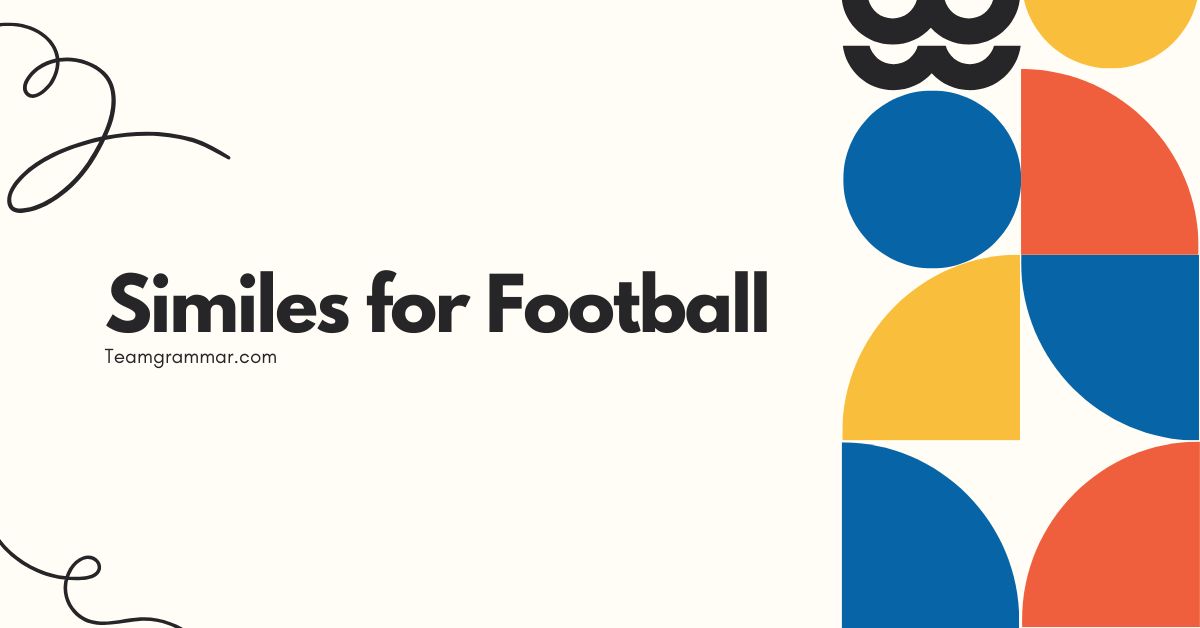49 Similes for Football: Enhancing Language and Imagery
Understanding similes is crucial for enriching your descriptive language, especially when discussing dynamic topics like football. Similes allow you to create vivid comparisons, making your writing or speech more engaging and understandable.
This article delves into the world of similes specifically tailored for football, providing a comprehensive guide suitable for students, writers, sports enthusiasts, and anyone looking to improve their expressive language skills. By mastering these similes, you can paint a clearer and more compelling picture of the game.
Table of Contents
- Introduction
- Definition of Simile
- Structural Breakdown of Similes
- Types of Football Similes
- Examples of Football Similes
- Usage Rules for Football Similes
- Common Mistakes with Similes
- Practice Exercises
- Advanced Topics in Similes
- FAQ: Frequently Asked Questions
- Conclusion
Definition of Simile
A simile is a figure of speech that compares two unlike things using the words “like” or “as.” Its primary function is to enhance description by drawing a parallel between something familiar and something less familiar, making the latter more vivid and understandable. Similes are a type of figurative language, falling under the broader category of comparisons, which also includes metaphors and analogies.
While metaphors state that one thing *is* another, similes merely suggest a resemblance. For instance, saying “He is a lion on the field” is a metaphor, while saying “He is *like* a lion on the field” is a simile.
In the context of football, similes can be used to describe a player’s speed, strength, agility, or even the overall atmosphere of a game. They add color and depth to the narrative, making it more engaging for the audience.
By using similes effectively, writers and speakers can evoke strong imagery and create a more memorable experience for their readers or listeners.
Structural Breakdown of Similes
The basic structure of a simile involves three key components: the subject, the comparison word (like or as), and the object of comparison. The subject is the thing being described, the comparison word establishes the connection, and the object of comparison provides the basis for the comparison.
Understanding this structure is crucial for creating effective and meaningful similes.
Here’s a breakdown of the structural elements:
- Subject: The person, place, thing, or idea being described.
- Comparison Word: Usually “like” or “as.”
- Object of Comparison: The thing the subject is being compared to.
For example, in the simile “He runs like the wind,” “he” is the subject, “like” is the comparison word, and “the wind” is the object of comparison. The simile suggests that the person runs with a speed and fluidity similar to that of the wind.
The effectiveness of a simile depends on the clarity and relevance of the comparison. The object of comparison should be something that the audience can easily visualize and understand, allowing them to grasp the intended meaning of the simile quickly.
Types of Football Similes
Football similes can be categorized based on the aspect of the game they describe. Here are a few common types:
Similes Describing Speed
These similes focus on the velocity and quickness of players or the ball.
Similes Describing Strength
These similes highlight the physical power and force of players.
Similes Describing Agility
These similes emphasize the nimbleness and dexterity of players.
Similes Describing Strategic Play
These similes illustrate the cleverness and planning involved in the game.
Similes Describing the Atmosphere
These similes capture the intensity and excitement of the game environment.
Examples of Football Similes
To illustrate the use of similes in football, here are several examples categorized by the aspect of the game they describe. Each table provides a variety of similes to enhance your understanding and inspire your own creative writing.
Similes Describing Speed
The following table includes similes that describe speed in the context of football. They are designed to highlight the quickness of players, the velocity of the ball, and the overall pace of the game.
| Simile | Explanation |
|---|---|
| He runs like a cheetah. | He is extremely fast, similar to the fastest land animal. |
| The ball flew like a rocket. | The ball traveled at a high speed, like a projectile. |
| He moved like lightning across the field. | His movements were sudden and incredibly fast. |
| She sprints like a greyhound. | She is a very fast runner, like a racing dog. |
| The pass was as quick as a flash. | The pass was executed with remarkable speed. |
| He dodged the defenders like a hummingbird. | He moved with great speed and agility, similar to a hummingbird’s flight. |
| His speed is like a bullet. | He is very fast, similar to the speed of a bullet. |
| The receiver shot off like a cannonball. | The receiver started running very quickly and powerfully. |
| He accelerates like a race car. | He increases his speed rapidly, similar to a race car. |
| The ball zipped through the air as fast as an arrow. | The ball traveled quickly and directly, like an arrow shot from a bow. |
| He’s as quick as a hiccup. | He’s extremely fast and sudden in his movements. |
| She ran like the wind. | She ran very fast, with the speed of the wind. |
| The kickoff went off like a dart. | The kickoff was launched quickly and precisely, like a dart. |
| He dashes like a scalded cat. | He runs very quickly, as if startled or frightened. |
| The quarterback released the ball as fast as a blink. | The quarterback threw the ball with incredible speed. |
| His first step is like a coiled spring. | His initial movement is explosive and fast. |
| The punt soared like an eagle. | The punt traveled high and fast, like an eagle in flight. |
| He’s off like a shot. | He starts running very quickly. |
| The wide receiver was as fast as greased lightning. | The receiver was incredibly fast and difficult to catch. |
| He cuts like a knife through butter. | He moves through the defense easily and quickly. |
| The defensive back was as swift as a shadow. | The defensive back moved quickly and stealthily. |
| The running back exploded through the line like a firework. | The running back burst through the line with great speed and force. |
Similes Describing Strength
This table provides examples of similes focusing on strength in football, highlighting the power of players, the force of tackles, and the overall physical intensity of the game.
| Simile | Explanation |
|---|---|
| He hits like a truck. | He tackles with great force and impact. |
| His grip is like a vise. | His hold is extremely strong and unyielding. |
| He’s as strong as an ox. | He possesses immense physical strength. |
| The linebacker is like a brick wall. | The linebacker is very difficult to break through or move. |
| His tackle felt like a train hitting me. | The tackle was extremely forceful and painful. |
| He’s as sturdy as an oak tree. | He is physically robust and resilient. |
| His punch was like a sledgehammer. | His punch was very powerful and impactful. |
| He’s built like a tank. | He is physically large and powerful. |
| The lineman is as solid as a rock. | The lineman is very stable and difficult to move. |
| His hold on the ball was like iron. | His grip on the ball was very strong and secure. |
| He is as immovable as a mountain. | He is very difficult to move or push. |
| His throws felt like a cannon blast. | His throws were powerful and forceful. |
| The impact of the collision was like thunder. | The collision was loud and powerful. |
| He’s as tough as nails. | He is very resilient and strong. |
| His shoulders are like boulders. | His shoulders are broad and strong. |
| The offensive line is as impenetrable as a fortress. | The offensive line is very difficult to break through. |
| He’s as unwavering as a sequoia. | He is very strong and steadfast. |
| His grip on victory was like a bear hug. | His hold on victory was firm and secure. |
| He’s as robust as a bull. | He is physically strong and energetic. |
| His blocks are like concrete barriers. | His blocks are very strong and effective. |
| The force of the sack was like an earthquake. | The sack was extremely powerful and disruptive. |
| He tackled him like a wrecking ball. | He tackled him with great force and destruction. |
Similes Describing Agility
The table below provides similes focused on describing agility in football, emphasizing the nimbleness, flexibility, and quick movements of players.
| Simile | Explanation |
|---|---|
| He moves like a cat. | He is agile and graceful in his movements. |
| His footwork is like a dancer’s. | His footwork is precise and coordinated. |
| He weaves through defenders like water. | He moves fluidly and effortlessly around defenders. |
| He’s as nimble as a monkey. | He is very agile and quick in his movements. |
| His turns are as sharp as a razor. | His turns are quick and precise. |
| He dodges like a fly. | He avoids tackles with quick and erratic movements. |
| His agility is like a gymnast’s. | His agility is graceful and controlled. |
| He’s as flexible as rubber. | He can bend and twist easily. |
| His spins are like a top. | He can spin quickly and smoothly. |
| He navigates the field like a maze runner. | He moves skillfully through complex situations. |
| He’s as elusive as a ghost. | He is difficult to catch or pin down. |
| His jukes are like lightning strikes. | His jukes are sudden and unpredictable. |
| He flows like a river around obstacles. | He moves smoothly and effortlessly. |
| He’s as light-footed as a ballerina. | He moves with grace and precision. |
| His balance is like a tightrope walker’s. | He maintains his balance with skill and control. |
| He pivots like a dancer. | He changes direction quickly and gracefully. |
| He’s as quick on his feet as a boxer. | He moves with speed and agility. |
| His leaps are like a gazelle’s. | He jumps with grace and power. |
| He’s as slippery as an eel. | He is difficult to hold onto. |
| His cuts are as precise as a surgeon’s. | He changes direction with great accuracy. |
| He dances around defenders like a matador. | He skillfully avoids tackles. |
| He’s as agile as a squirrel in the trees. | He moves quickly and easily. |
Similes Describing Strategic Play
This table presents similes describing the strategic aspects of football, emphasizing the intelligence, planning, and cleverness involved in the game.
| Simile | Explanation |
|---|---|
| His plays are as calculated as a chess game. | His strategies are carefully planned and executed. |
| The team’s strategy unfolded like a blueprint. | The team’s plan was clear and well-defined. |
| His decisions are as precise as a surgeon’s cut. | His choices are accurate and well-considered. |
| They executed the play like a well-oiled machine. | The play was executed smoothly and efficiently. |
| His strategy is like a magician’s trick. | His plan is deceptive and surprising. |
| They moved the ball down the field like a conductor leading an orchestra. | They coordinated their movements skillfully to advance. |
| His game plan is as intricate as a spider’s web. | His strategy is complex and carefully constructed. |
| They adapted their strategy like chameleons changing color. | They adjusted their plan to suit the changing circumstances. |
| His leadership is like a general commanding an army. | His leadership is strong and effective. |
| The defense was like a puzzle the offense couldn’t solve. | The defense was difficult to understand and overcome. |
| His play-calling is as unpredictable as the weather. | His choices are surprising and varied. |
| Their teamwork is like a perfectly synchronized dance. | Their collaboration is seamless and effective. |
| His anticipation is like a fortune teller’s prediction. | He is able to foresee upcoming events accurately. |
| Their game plan is as solid as a fortress. | Their strategy is strong and impenetrable. |
| His adjustments are like a master craftsman fine-tuning his work. | His adaptations are precise and effective. |
| Their execution is as smooth as silk. | Their performance is flawless and elegant. |
| His vision on the field is like having eyes in the back of his head. | He is aware of everything happening around him. |
| Their coordination is as precise as clockwork. | Their collaboration is perfectly timed and synchronized. |
| His maneuvers were as unexpected as a plot twist. | His actions were surprising and unpredictable. |
| Their offense moved like a well-choreographed ballet. | Their movements were graceful and coordinated. |
| His play-calling was as deceptive as a mirage. | His choices were misleading and confusing. |
| Their strategy was as airtight as a sealed vault. | Their plan was secure and impenetrable. |
Similes Describing the Atmosphere
The following table contains similes focused on describing the atmosphere of a football game, highlighting the intensity, excitement, and overall environment of the event.
| Simile | Explanation |
|---|---|
| The crowd roared like a hurricane. | The crowd’s noise was loud and powerful. |
| The tension was as thick as fog. | The atmosphere was heavy with anticipation. |
| The stadium was as electric as a lightning storm. | The atmosphere was charged with excitement. |
| The fans were as passionate as a wildfire. | The fans were extremely enthusiastic and fervent. |
| The pressure was like a ton of bricks. | The stress was overwhelming and intense. |
| The excitement was as contagious as a cold. | The enthusiasm spread quickly among the crowd. |
| The atmosphere was as intense as a battlefield. | The environment was filled with competition and conflict. |
| The rivalry was as bitter as poison. | The competition was hostile and acrimonious. |
| The anticipation was like waiting for a bomb to drop. | The expectation was filled with suspense and anxiety. |
| The celebration was as wild as a jungle. | The festivities were unrestrained and chaotic. |
| The stadium was as alive as a beehive. | The venue was bustling with activity and energy. |
| The energy in the stadium was like a tidal wave. | The excitement surged powerfully through the crowd. |
| The silence was as heavy as lead. | The quiet was profound and oppressive. |
| The atmosphere crackled like static electricity. | The environment was tense and charged. |
| The disappointment was as crushing as a heartbreak. | The sadness was intense and overwhelming. |
| The stadium shook like an earthquake. | The venue vibrated with excitement and noise. |
| The fans erupted like a volcano. | The supporters expressed their excitement explosively. |
| The mood was as somber as a funeral. | The atmosphere was serious and mournful. |
| The tension was as palpable as a physical presence. | The stress was easily felt by everyone. |
| The victory felt as sweet as honey. | The win was extremely satisfying. |
| The fans cheered like a swarm of bees. | The supporters made a loud and buzzing noise. |
| The stadium was as bright as a supernova. | The venue was filled with light and energy. |
Usage Rules for Football Similes
Using similes effectively requires adherence to certain rules. The primary rule is to ensure that the comparison is logical and relevant.
The object of comparison should be something that the audience is familiar with, and the comparison should highlight a specific quality or characteristic that both the subject and the object share.
Here are some key usage rules:
- Relevance: The comparison must be relevant to the subject being described.
- Clarity: The simile should be easy to understand.
- Originality: Strive for fresh and creative comparisons to avoid clichés.
- Context: Ensure the simile fits the tone and style of your writing or speech.
Avoid using similes that are too generic or overused, such as “He is as fast as a car” (unless the context specifically requires it). Instead, opt for more specific and imaginative comparisons that create a stronger impact.
Common Mistakes with Similes
Several common mistakes can weaken the effectiveness of similes. One frequent error is using comparisons that are illogical or nonsensical.
For example, saying “He runs like a tree” doesn’t make sense because trees are stationary.
Another common mistake is using similes that are too vague or general. Saying “He is like a good player” doesn’t provide any specific information about the player’s qualities.
Instead, use more precise comparisons, such as “He is as strategic as a chess grandmaster.”
Here are some examples of common mistakes and their corrections:
| Incorrect Simile | Corrected Simile | Explanation |
|---|---|---|
| He is as fast as a turtle. | He is as fast as a cheetah. | Turtles are slow, while cheetahs are fast, creating a relevant comparison. |
| The game was like something. | The game was as intense as a championship final. | The corrected simile provides a specific and vivid comparison. |
| He is strong like something. | He is as strong as an ox. | The corrected simile uses a well-known symbol of strength. |
| The crowd was loud like something. | The crowd roared like a hurricane. | The corrected simile provides a powerful and descriptive comparison. |
| His agility is like a thing. | His agility is like a cat’s. | The corrected simile uses a known agile animal for comparison. |
Practice Exercises
Test your understanding of similes with these practice exercises. Fill in the blanks with appropriate similes to complete the sentences.
Exercise 1: Complete the Similes
Complete the following sentences with appropriate similes related to football.
| Question | Answer |
|---|---|
| 1. He tackled the player __________. | 1. He tackled the player like a freight train. |
| 2. The quarterback threw the ball __________. | 2. The quarterback threw the ball as fast as a rocket. |
| 3. The crowd roared __________. | 3. The crowd roared like a pack of wolves. |
| 4. His footwork was __________. | 4. His footwork was like a dancer’s. |
| 5. The receiver caught the ball __________. | 5. The receiver caught the ball as securely as a vise. |
| 6. The running back dodged defenders __________. | 6. The running back dodged defenders like a hummingbird. |
| 7. His grip on the ball was __________. | 7. His grip on the ball was like iron. |
| 8. The stadium was __________. | 8. The stadium was as electric as a lightning storm. |
| 9. The coach planned the strategy __________. | 9. The coach planned the strategy as carefully as a chess master. |
| 10. The defensive line was __________. | 10. The defensive line was as impenetrable as a fortress. |
Exercise 2: Identify the Simile
Identify the simile in each of the following sentences.
| Question | Answer |
|---|---|
| 1. The player was as quick as lightning, dodging every tackle. | 1. as quick as lightning |
| 2. The tension in the stadium was thick, like a heavy fog. | 2. like a heavy fog |
| 3. He moved through the defense like water flowing around rocks. | 3. like water flowing around rocks |
| 4. The team worked together like a well-oiled machine, scoring effortlessly. | 4. like a well-oiled machine |
| 5. The fans cheered as loudly as a roaring waterfall. | 5. as loudly as a roaring waterfall |
| 6. The quarterback’s throw was as precise as a surgeon’s cut. | 6. as precise as a surgeon’s cut |
| 7. The player ran like a cheetah, leaving everyone in the dust. | 7. like a cheetah |
| 8. The defender stood as tall as a mountain, blocking every pass. | 8. as tall as a mountain |
| 9. The atmosphere in the stadium was as charged as a lightning storm. | 9. as charged as a lightning storm |
| 10. The running back was as elusive as a ghost, impossible to catch. | 10. as elusive as a ghost |
Exercise 3: Rewrite Using Similes
Rewrite the following sentences using similes to make them more descriptive.
| Original Sentence | Rewritten Sentence with Simile |
|---|---|
| 1. The player was very fast. | 1. The player was as fast as a cheetah. |
| 2. The stadium was very loud. | 2. The stadium was as loud as a roaring thunder. |
| 3. The tackle was very strong. | 3. The tackle was like a freight train hitting him. |
| 4. The quarterback was accurate. | 4. The quarterback’s throws were as accurate as a dart. |
| 5. The receiver was agile. | 5. The receiver was as agile as a cat. |
| 6. The game was intense. | 6. The game was as intense as a battle. |
| 7. The crowd was excited. | 7. The crowd was as excited as bees in a hive. |
| 8. The strategy was clever. | 8. The strategy was as clever as a fox. |
| 9. The defense was strong. | 9. The defense was like an impenetrable wall. |
| 10. The win was satisfying. | 10. The win was as sweet as honey. |
Advanced Topics in Similes
For advanced learners, exploring more complex aspects of similes can further enhance their writing and speaking abilities. This includes understanding the nuances of creating original similes, using similes for specific rhetorical effects, and analyzing similes in literature and speeches.
Extended Similes: These are similes that are developed over several sentences or even paragraphs, providing a more detailed and elaborate comparison. They are often used to create a richer and more immersive experience for the reader.
Subverted Similes: These are similes that intentionally break the expected pattern or create an unexpected comparison for humorous or ironic effect.
Similes in Figurative Language Analysis: Understanding how similes contribute to the overall meaning and impact of a text is a crucial skill for literary analysis. Analyze the similes used by famous authors and speakers to understand their techniques and strategies.
FAQ: Frequently Asked Questions
Here are some frequently asked questions about similes, particularly in the context of football.
- What is the difference between a simile and a metaphor?
A simile compares two things using “like” or “as,” while a metaphor states that one thing *is* another. For example, “He is *like* a lion” (simile) versus “He *is* a lion” (metaphor).
- Why are similes useful in describing football?
Similes help create vivid and engaging descriptions of the game, making it easier for the audience to visualize and understand the action. They add color and depth to the narrative.
- How can I create original and effective similes?
Focus on specific qualities you want to highlight and brainstorm objects or concepts that share those qualities. Avoid clichés and strive for fresh, imaginative comparisons.
- What should I avoid when using similes?
Avoid illogical comparisons, overused clichés, and vague or general similes that don’t provide specific information.
- Can similes be used in any type of writing?
Yes, similes can be used in various types of writing, including descriptive essays, narratives, poetry, and even technical reports, to enhance understanding and engagement.
- How do similes enhance persuasive writing?
Similes can make arguments more relatable and understandable by comparing complex or abstract concepts to familiar ones, thereby strengthening the persuasive impact.
- Are there any cultural considerations when using similes?
Yes, be mindful of cultural differences and ensure that the objects of comparison are familiar and relevant to your target audience to avoid confusion or misinterpretation.
- How can I improve my simile-writing skills?
Practice regularly by writing descriptions using similes, reading examples in literature, and seeking feedback from others. Pay attention to how professional writers use similes to create vivid imagery.
- What role do similes play in sports commentary?
Similes are used to make sports commentary more exciting and descriptive, helping listeners or viewers better visualize the action and understand the intensity of the game.
- How do similes help in creating a narrative around a football game?
Similes add depth and color to the narrative, making it more engaging and memorable for the audience. They create vivid images and enhance the emotional impact of the story.
Conclusion
Mastering the use of similes is an invaluable skill for anyone looking to enhance their descriptive language, especially in the context of dynamic subjects like football. By understanding the structure, types, and usage rules of similes, you can create vivid comparisons that bring your writing and speech to life.
Remember to focus on relevance, clarity, and originality to craft effective and engaging similes that resonate with your audience.
Practice regularly, analyze examples from literature and sports commentary, and seek feedback to refine your skills. With dedication and creativity, you can harness the power of similes to paint a clearer and more compelling picture of the game, enriching the experience for yourself and your audience.
Keep exploring and experimenting with different comparisons to discover your unique voice and style in using similes.







